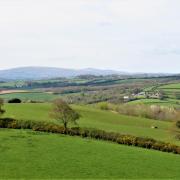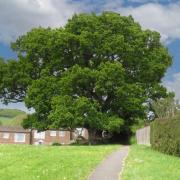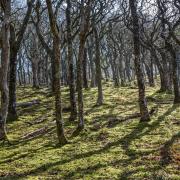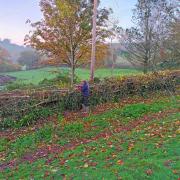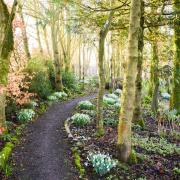ANDY COOPER learns all there is to know about bees as he joins some Devon-based experts for a unique insight into their business
Somewhere in Ye Olde Book of Journalism Clichés, under B for bees, it unequivocally states that you must, at some point, use the word ‘buzz’ or ‘buzzing’ in your story. If a bees’ nest is discovered, or there is a close-up picture of one gathering nectar from a plant, it’s pretty much de rigueur to crowbar in the B-word to make your story complete.
And yet, as I reflect on my visit to Firscroft Honey Bees and my opportunity to get up close and personal with the honey-making process, the truth is I DID get a buzz out of the whole experience. I felt a real adrenalin kick at being so close to nature and learning so much about these fascinating insects.

Firscroft Honey Bees is the brainchild of bee farmers John and Isla Taylor. They have around 100 hives across 14 apiary sites in Torbay and the South Hams, producing not only honey but also beauty products which are a by-product of their harvest. They supply Occombe Farm shop and some other small outlets in the local area.
As Isla explains: “It's been a massive learning curve and a complete change to the life we did have - it's hard work to look after these beautiful insects and it is unlikely to make us financially rich but we find ourselves richer in so many ways, enjoying the outdoors, the lovely landowners we've met, time with our children etc.”
After a morning spent with them both, I can vouch for the benefits Isla outlines. Meeting the couple down a leafy lane near Torquay, we drive into a secluded farm field and there, down in the corner past some grazing llamas, are the beehives.
As we don our protective gear (although as a veteran of beekeeping John says the occasional sting is par for the course), I am full of anticipation for what lies ahead. John explains there is really nothing to be scared of about approaching and working with a hide thus: “The bees are working and doing what they exist for – to sustain the queen. And so you really have to get in their way and annoy them to get stung.”

First stage in the exploration of the hives is the smoke canister, which John puffs gently into the openings in order to calm the bees. Then he loosens the lid and opens it. Whereas I have been conscious of one or two bees buzzing in and out of the hive when we were approaching with the lid off, there we are – thousands of them in a shifting, moving mass.
It is quite the sight. As I gently lift up one of the panels for close inspection, they almost look like one single living organism. We are not only checking on the honey, but the bees’ welfare too. John is on the lookout for any tell-tale signs that all is not well as disease has in recent time decimated the UK bee population.
“Bees are so vital to our ecology,” John explains. “They are essential for pollinating lots of crops and without them our diets would be an awful lot less varied than they are now. The planet needs bees to thrive and prosper, irrespective of the by-product they produce.”

That by-product, of course, consists of not only honey, but beeswax too. Nothing goes to waste from the hive and John collects just about everything from the production cycle, meaning Isla has enough wax to turn into a range of beauty and home products, which are proving to be more and more popular.
But it’s really the honey we are here for! It’s early in the season when I visit and yet there is that golden nectar already forming. Clear and pure, John says it is one of the healthiest foodstuffs around. “It makes me smile when I see a sell-by date on a jar of honey,” he laughs. “I know we have to do it for regulations, but honestly honey could be around for hundreds of years and still be edible. It is so pure.”
John explains how the hive is run on a very rigid system where every bee has a role.
Drones, or male honey bees, have only one task: to fertilise new queens, whereas the females, or worker bees, constitute the largest population in the colony. Each worker bee, guided by a biological clock, assumes different responsibilities and performs specific job duties as she reaches a certain age.
And then there is the queen bee. She is the only fertile female in the colony. A queen bee lives for three to five years. However, when she falters in her egg-laying performance, the hive will start looking for a replacement and feed royal jelly to a developing larva.

So, where is our queen? To the amateur eye it’s hard to spot her, but after lifting out a few more panels, John points to her in amongst her fellow bees and yes, it is clear who she is. What is so impressive is the hierarchical structure whose sole existence and purpose is to keep the hive healthy and the queen alive.
Hive duly checked we put the lid back on and turn to inspect another. John is so passionate about hives and keeping bees, he even produces these bespoke hives for sale as well as bee-keeping equipment for enthusiasts. Also proving ever more popular are John’s bee-keeping experience days, where guests get to try out the Firscroft experience first-hand.
“It’s something which is very easy to get passionate about and more and more people are taking it up as a hobby or even professionally,” explains John. “I was something of an amateur enthusiast for years and then when my corporate career was coming to an end, I thought what would I rather do...still be sitting in meetings in boardrooms or have my ‘office’ out here in the countryside, doing something I love?”
As the buzz of bees around the hive gently interrupts the quietness and tranquillity of nature all around us, it is hard to argue with that sentiment.









